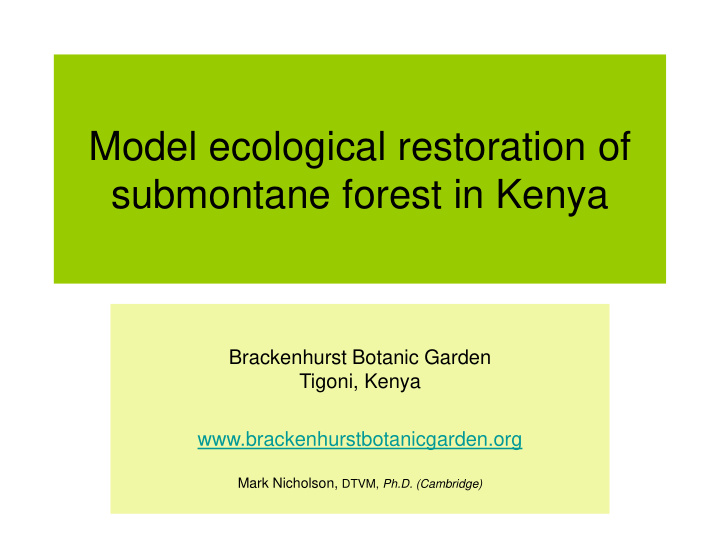



Model ecological restoration of submontane forest in Kenya Brackenhurst Botanic Garden Tigoni, Kenya www.brackenhurstbotanicgarden.org Mark Nicholson, DTVM, Ph.D. (Cambridge)
Ecological restoration in practice • The context in Kenya • Principles of restoration in relation to FLR • The process on site • Environmental education • A forest in more than trees: trophic levels
The context Threats to biodiversity and ecosystems in Kenya
Rate of total destruction (land use change) >> rate of restoration
Very poor security; collusion with forest officials.
Threats: Degradation (irrecoverable in the short term)
Threats: land use change, smallholder agriculture; urbanization, plantation crops
Tea country (1800-2000m): plantations of wattle, eucalyptus, Grevillea; windbreaks of Hakea; scattered indigenous trees. Valleys dry for 6 months a year.
Collecting sites • Loima • Marsabit • Mt. Kulal • Ndotos • Matthews • Kakamega • Cherangani • Aberdares • Mt. Kenya • Nairobi • Mara/ Loita/ Nguruman • Chyulu Hills • Kilimanjaro (Kenya) • Kitui (Mutha/ Endau) • Taita hills/ Kasigau
Brackenhurst forest • Altitude: 2050-2200m; +1200mm rainfall • Ecologically degraded area, now reverting to a natural submontane forest ecosystem • 110,000 woody native plants grown (5 year survival rate is 90%). NO natural regeneration • Also collect from dryland, rainforest (from W. Kenya), woodland and grassland species all ex situ and many disappearing naturally • 1500 plant species (>500 woody species of trees, shrubs & climbers; >140 families)
Sources of taxa
Cassine schlechteranum …from dry forest
Ex situ conservation
Ex situ conservation: Widdrintonia whytei & Cylicomorpha Ex situ W. cedarbergensis parviflora conservation
2000: 99% exotic species Note this tree ( Pouteria adolfi- friedericii ) Black wattle Eucalyptus Cypress
Brackenhurst Botanic Garden in 2017 Ecological restoration project 2000-2030 (99% indigenous) Same tree 17 years later Our aim: to recreate a ‘natural’ forest
2010 from Government land: note cattle and wetland barrier
General restoration principles 5. Dryland reforestation is much more 1. Restoring is not restoration: Bonn challenge mentions 150m ha challenging because of vicissitudes of climate. RESTORED by 2020, and 350 m ha by 2030. 6. Two types of forest restoration: a) Enrichment (active or passive), 2. e.g. Kenya target is 5m ha. OR Ethiopia “ will have RESTORED ” b) Land use change back to 15m ha by 2020. original ecosystem (TOTAL & 3. International/ national ACTIVE restoration. commitments are necessary but should be realistic and Most projects are about enrichment achievable. 4. Have the indicators of restoration 7. Livestock (wildlife?) are major been spelled out? Restoration is handicaps in successful restoration. NOT about numbers of trees 8. A forest is more than trees planted.
Native forest restoration 1. Is FLR about native forest 5. Our project is the creation of a natural forest…is this an oxymoron? restoration or land restoration?? If it is land restoration, what is the 6. FLR, as we interpret it, should be endpoint? ecological restoration of: 2. Is it ignoring the rangelands and - NATIVE plant and animal biodiversity GRASS? The major causes of - trophic levels rangeland degradation are - ecosystem services overgrazing and gradual removal - edaphic factors: S.O.M., fertility, of woodland species. structure, water infiltration rates 3. Total forest restoration takes 7. Know your biodiversity, because you TIME & MONEY. We set a target cannot restore if you don’t of 30 years (2000-2030) for 8. In our forest we set a goal of >250 restoring a 40 ha patch of forest. identified plant species per 2ha. 4. A block of one or two species of block (>50 spp. of trees), inclu. indigenous tree may be a forest herbs, Poaceae, Pteridophyta, but is NOT ecological restoration Bryophyta etc
Calanthe sylvatica Eulophia stenophylla
Oplismenus hirtellus Oplismenus undulatifolius
Euphorbia prostrata
Low biodiversity
Total restoration The process
NO regeneration of native trees as the area had been a gum. Cypress or wattle forest for > 60 years
In 2000, Brackenhurst had <20 indigenous trees but a nearby forest has about 50 woody species. Common species include: Araliaceae: Polyscias kikuyensis Clusiaceae: Garcinia volkensii Euphorbiaceae: Croton megalocarpus/ C. macrostachyus Euphorbiaceae Macaranga kilimandscharica Lauraceae: Ocotea keniensis (O. usambarensis extirpated?) Malvaceae: Cola greenwayi Meliaceae : Ekebergia capensis Moraceae: Ficus thonningii Olacaceae: Strombosia scheffleri Phyllanthaceae Margaritaria discoidea Rosaceae: Prunus africana Rubiaceae: Psychotria mahonii/ P. fractinervata Rutaceae: Zanthoxylum gillettii / Clausena anisata Rutaceae V epris simplicifolia Salicaceae: Casaeria battiscombei Sapotaceae: Pouteria adolfi-friedericii Sapotaceae: Chrysophyllum gorungosanum
Why we prefer scientific names Croton megalocarpus • Eng: • Nandi: none Masineitet • Luhya: • Taita: Musine Mukigara • Boran: • Gabbra: Nyaap’po Napo • Kikuyu: • Luganda: Nkulumire Mukinduri • Maa: • Buddu: Olmergoit Mbula • Tugen: • Rukiga: Ortuet Mutakura • Samburu: Lameruguet • Rutoro: Munyabakuru • Kamba: Muthulu/ Kithulu • Runyankore: Mutagunda • Pokot: Korelach
Note grass, woodland spp. (acacia [ S. xanthophloea ])
15 years later Reforestation under former cypress: no regrowth, no invasives, easy to restore if understory plants proactively planted
Replanting on land formerly under gum & wattle very difficult
Former gum plantation: no active understory planting but invasives cleared. Trees fine, light shade.
Basella alba
60 years under wattle: S.O.M. >2- 3% 17 years under indigenous forest; S.O.M. just below leaf litter layer + 24%
Environmental education Three main targets: • The Youth • Women • Professionals
Environmental education: Global initiative service Summit: visit to Brackenhurst Feb 23 rd 2013
Lack of knowledge of plant identification, ecology & taxonomy • In 2017 we had a training course on ecological restoration: 29 attendees from 2 govt. institutions and 7 NGOs. • We quizzed them on 25 less common species asking for Family, Genus, Species & vernacular name (Max. 100 marks) • Median score 7/100 (one person got 34) N.B. Regional training course in 2017/18 on plant identification
Loss of indigenous knowledge leads to loss of indigenous biodiversity Which of the following 6 simple, lobed leaves is ecologically the odd one out?
X Ficus exasperata Obetia radula Cola gigantea Macaranga Cylicomorpha schweinfurthii parviflora
V. simplicifolia V. eugenifolia (R) V. trichocarpa V. fadenii (very rare) V. nobilis V. glandulosa (rare local endemic)
Recommend
More recommend